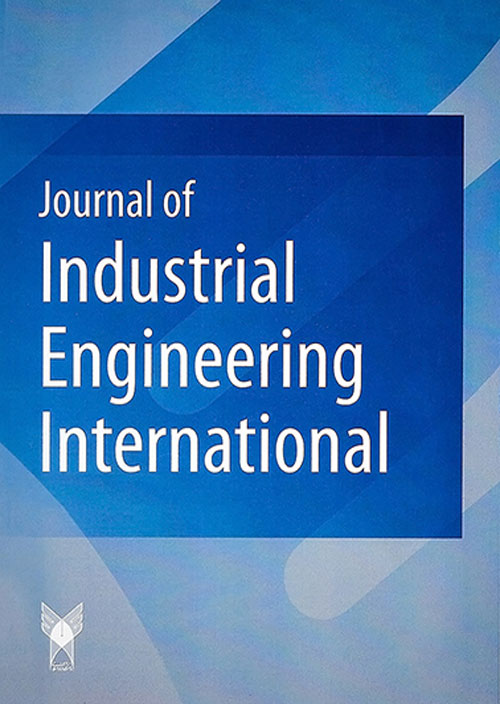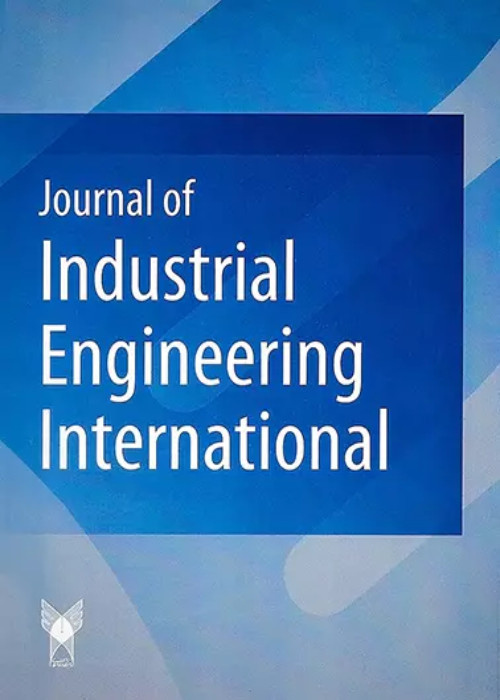فهرست مطالب

Journal Of Industrial Engineering International
Volume:13 Issue: 2, Spring 2017
- تاریخ انتشار: 1396/03/11
- تعداد عناوین: 10
-
-
Pages 143-159
Integration of production planning and scheduling is a class of problems commonly found in manufacturing industry. This class of problems associated with precedence constraint has been previously modeled and optimized by the authors, in which, it requires a multidimensional optimization at the same time: what to make, how many to make, where to make and the order to make. It is a combinatorial, NP-hard problem, for which no polynomial time algorithm is known to produce an optimal result on a random graph. In this paper, the further development of Genetic Algorithm (GA) for this integrated optimization is presented. Because of the dynamic nature of the problem, the size of its solution is variable. To deal with this variability and find an optimal solution to the problem, GA with new features in chromosome encoding, crossover, mutation, selection as well as algorithm structure is developed herein. With the proposed structure, the proposed GA is able to “learn” from its experience. Robustness of the proposed GA is demonstrated by a complex numerical example in which performance of the proposed GA is compared with those of three commercial optimization solvers.
Keywords: Genetic algorithm, Optimization, Precedence constraint, Integration of planning, scheduling, Variable-length chromosome -
Pages 161-169
Robust supplier selection problem, in a scenario-based approach has been proposed, when the demand and exchange rates are subject to uncertainties. First, a deterministic multi-objective mixed integer linear programming is developed; then, the robust counterpart of the proposed mixed integer linear programming is presented using the recent extension in robust optimization theory. We discuss decision variables, respectively, by a two-stage stochastic planning model, a robust stochastic optimization planning model which integrates worst case scenario in modeling approach and finally by equivalent deterministic planning model. The experimental study is carried out to compare the performances of the three models. Robust model resulted in remarkable cost saving and it illustrated that to cope with such uncertainties, we should consider them in advance in our planning. In our case study different supplier were selected due to this uncertainties and since supplier selection is a strategic decision, it is crucial to consider these uncertainties in planning approach.
Keywords: Supplier selection, Robust programming, Discount, Currency exchange rate uncertainty -
Pages 171-180
This study is concerned with the performance modeling of a fault tolerant system consisting of operating units supported by a combination of warm and cold spares. The on-line as well as warm standby units are subject to failures and are send for the repair to a repair facility having single repairman which is prone to failure. If the failed unit is not detected, the system enters into an unsafe state from which it is cleared by the reboot and recovery action. The server is allowed to go for vacation if there is no failed unit present in the system. Markov model is developed to obtain the transient probabilities associated with the system states. Runge–Kutta method is used to evaluate the system state probabilities and queueing measures. To explore the sensitivity and cost associated with the system, numerical simulation is conducted.
Keywords: Fault tolerant system, Server vacation, Machine repair, Queue length, Imperfect coverage, Reboot, Unreliable server, Runge -Kutta method -
Pages 181-198
A target-based MADM method covers beneficial and non-beneficial attributes besides target values for some attributes. Such techniques are considered as the comprehensive forms of MADM approaches. Target-based MADM methods can also be used in traditional decision-making problems in which beneficial and non-beneficial attributes only exist. In many practical selection problems, some attributes have given target values. The values of decision matrix and target-based attributes can be provided as intervals in some of such problems. Some target-based decision-making methods have recently been developed; however, a research gap exists in the area of MADM techniques with target-based attributes under uncertainty of information. We extend the MULTIMOORA method for solving practical material selection problems in which material properties and their target values are given as interval numbers. We employ various concepts of interval computations to reduce degeneration of uncertain data. In this regard, we use interval arithmetic and introduce innovative formula for interval distance of interval numbers to create interval target-based normalization technique. Furthermore, we use a pairwise preference matrix based on the concept of degree of preference of interval numbers to calculate the maximum, minimum, and ranking of these numbers. Two decision-making problems regarding biomaterials selection of hip and knee prostheses are discussed. Preference degree-based ranking lists for subordinate parts of the extended MULTIMOORA method are generated by calculating the relative degrees of preference for the arranged assessment values of the biomaterials. The resultant rankings for the problem are compared with the outcomes of other target-based models in the literature.
Keywords: MULTIMOORA, Multiple attribute decisionmaking, Target-based attributes, Interval distance, Preference degree, Biomaterials selection -
Pages 199-213
Supplier selection and allocation of optimal order quantity are two of the most important processes in closed-loop supply chain (CLSC) and reverse logistic (RL). So that providing high quality raw material is considered as a basic requirement for a manufacturer to produce popular products, as well as achieve more market shares. On the other hand, considering the existence of competitive environment, suppliers have to offer customers incentives like discounts and enhance the quality of their products in a competition with other manufacturers. Therefore, in this study, a model is presented for CLSC optimization, efficient supplier selection, as well as orders allocation considering quantity discount policy. It is modeled using multi-objective programming based on the integrated simultaneous data envelopment analysis–Nash bargaining game. In this study, maximizing profit and efficiency and minimizing defective and functions of delivery delay rate are taken into accounts. Beside supplier selection, the suggested model selects refurbishing sites, as well as determining the number of products and parts in each network’s sector. The suggested model’s solution is carried out using global criteria method. Furthermore, based on related studies, a numerical example is examined to validate it.
Keywords: Closed- loop supply chain, Data envelopment analysis, Nash bargaining game, Supplier selection, Quantity discount policy -
Pages 215-228
High-density polyethylene (HDPE) pipes find versatile applicability for transportation of water, sewage and slurry from one place to another. Hence, these pipes undergo tremendous pressure by the fluid carried. The present work entails the optimization of the withstanding pressure of the HDPE pipes using Taguchi technique. The traditional heuristic methodology stresses on a trial and error approach and relies heavily upon the accumulated experience of the process engineers for determining the optimal process control parameters. This results in setting up of less-than-optimal values. Hence, there arouse a necessity to determine optimal process control parameters for the pipe extrusion process, which can ensure robust pipe quality and process reliability. In the proposed optimization strategy, the design of experiments (DoE) are conducted wherein different control parameter combinations are analyzed by considering multiple setting levels of each control parameter. The concept of signal-to-noise ratio (S/N ratio) is applied and ultimately optimum values of process control parameters are obtained as: pushing zone temperature of 166 °C, Dimmer speed at 08 rpm, and Die head temperature to be 192 °C. Confirmation experimental run is also conducted to verify the analysis and research result and values proved to be in synchronization with the main experimental findings and the withstanding pressure showed a significant improvement from 0.60 to 1.004 Mpa.
Keywords: Design of experiments (DOE), Analysis of variance (ANOVA), Signal to noise (S, N) ratio, Taguchi approach -
Pages 229-237
A decision making process requires the values of conflicting objectives for alternatives and the selection of the best alternative according to the needs of decision makers. Multi-objective optimization methods may provide solution for this selection. In this paper it is aimed to present the laptop selection problem based on MOORA plus full multiplicative form (MULTIMOORA) and multi-objective optimization on the basis of simple ratio analysis (MOOSRA) which are relatively new multi-objective optimization methods. The novelty of this paper is solving this problem with the MULTIMOORA and MOOSRA methods for the first time.
Keywords: Multi-objective decision making, MULTIMOORA method, MOOSRA method, Laptop selection -
Pages 239-247
The manufacturing operations often involve multistage processes where the process capability of each stage is affected by the process capability of its precedent processes. This property is known as the cascade property. The purpose of this paper is to estimate the process capability of the second stage of two-stage process while the cascade property impact is removed using residuals analysis. To this end, a method is proposed to determine the specification limits of the residuals based on the specification limits of the quality characteristics in the first and second stages. The C p, C pk and S pk indices are used to calculate the capability of the second stage in the two-stage process. The results of simulation study show the satisfactory performance of the proposed method in estimating the pure process capability of the second stage.
Keywords: Process capability index, Residuals, Two-stage process, Cascade property -
Pages 249-264
The article is centred on software system development for manufacturing company that produces polyethylene bags using mostly conventional machines in a competitive world where each business enterprise desires to stand tall. This is meant to assist in gaining market shares, taking maintenance and production decisions by the dynamism and flexibilities embedded in the package as customers’ demand varies under the duress of meeting the set goals. The production and machine condition monitoring software (PMCMS) is programmed in C# and designed in such a way to support hardware integration, real-time machine conditions monitoring, which is based on condition maintenance approach, maintenance decision suggestions and suitable production strategies as the demand for products keeps changing in a highly competitive environment. PMCMS works with an embedded device which feeds it with data from the various machines being monitored at the workstation, and the data are read at the base station through transmission via a wireless transceiver and stored in a database. A case study was used in the implementation of the developed system, and the results show that it can monitor the machine’s health condition effectively by displaying machines’ health status, gives repair suggestions to probable faults, decides strategy for both production methods and maintenance, and, thus, can enhance maintenance performance obviously.
Keywords: Production strategies, Machine monitoring, Maintenance, Decision tools -
Pages 265-273
The objective in traditional scheduling is usually time based. Minimizing the makespan, total flow times, total tardi costs, etc. are instances of these objectives. In manufacturing, processing each job entails a cost paying and price receiving. Thus, the objective should include some notion of managing the flow of cash. We have defined two new objectives maximization of average and minimum available cash. For single machine scheduling, it is demonstrated that scheduling jobs in decreasing order of profit ratios maximizes the former and improves productivity. Moreover, scheduling jobs in increasing order of costs and breaking ties in decreasing order of prices maximizes the latter and creates protection against financial instability.
Keywords: Scheduling, Single machine, Cash management, Cash deficiency, Manufacturing industries


